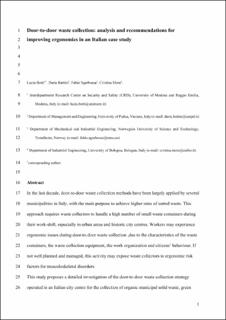| dc.contributor.author | Botti, Lucia | |
| dc.contributor.author | Battini, Daria | |
| dc.contributor.author | Sgarbossa, Fabio | |
| dc.contributor.author | Mora, Cristina | |
| dc.date.accessioned | 2021-02-24T12:07:10Z | |
| dc.date.available | 2021-02-24T12:07:10Z | |
| dc.date.created | 2020-05-11T20:06:28Z | |
| dc.date.issued | 2020 | |
| dc.identifier.citation | Waste Management. 2020, 109 149-160. | en_US |
| dc.identifier.issn | 0956-053X | |
| dc.identifier.uri | https://hdl.handle.net/11250/2730090 | |
| dc.description.abstract | In the last decade, door-to-door waste collection methods have been largely applied by several municipalities in Italy, with the main purpose to achieve higher rates of sorted waste. This approach requires waste collectors to handle a high number of small waste containers during their work-shift, especially in urban areas and historic city centres. Workers may experience ergonomic issues during door-to-door waste collection, due to the characteristics of the waste containers, the waste collection equipment, the work organization and citizens’ behaviour. If not well planned and managed, this activity may expose waste collectors to ergonomic risk factors for musculoskeletal disorders.
This study proposes a detailed investigation of the door-to-door waste collection strategy operated in an Italian city centre for the collection of organic municipal solid waste, green waste and residual waste. The aim is to investigate the impact of door-to-door waste collection strategies on the health and safety of the workers involved in this activity.
The results show that the lack of proper waste collection equipment determines poor ergonomics conditions during door-to-door collection of green waste. The poor design of operations and technology is the cause of ergonomic issues in the door-to-door collection of organic municipal solid waste and residual waste. Finally, work organization factors impact on the safety and health of all the waste collectors involved in this study.
A set of recommendations and suggestions are provided to managers, workers and citizens involved in door-to-door waste collection, showing that this activity can be sustainable if well designed and managed. | en_US |
| dc.language.iso | eng | en_US |
| dc.publisher | Elsevier | en_US |
| dc.rights | Attribution-NonCommercial-NoDerivatives 4.0 Internasjonal | * |
| dc.rights.uri | http://creativecommons.org/licenses/by-nc-nd/4.0/deed.no | * |
| dc.title | Door-to-door waste collection: Analysis and recommendations for improving ergonomics in an Italian case study | en_US |
| dc.type | Peer reviewed | en_US |
| dc.type | Journal article | en_US |
| dc.description.version | acceptedVersion | en_US |
| dc.source.pagenumber | 149-160 | en_US |
| dc.source.volume | 109 | en_US |
| dc.source.journal | Waste Management | en_US |
| dc.identifier.doi | 10.1016/j.wasman.2020.04.027 | |
| dc.identifier.cristin | 1810405 | |
| dc.description.localcode | "© 2020. This is the authors’ accepted and refereed manuscript to the article. Locked until 11.5.2022 due to copyright restrictions. This manuscript version is made available under the CC-BY-NC-ND 4.0 license http://creativecommons.org/licenses/by-nc-nd/4.0/ " | en_US |
| cristin.ispublished | true | |
| cristin.fulltext | preprint | |
| cristin.qualitycode | 1 | |

